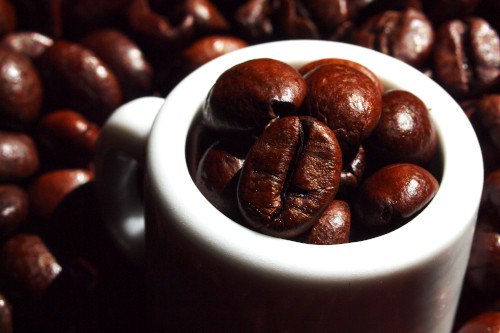There is nothing quite like opening a fresh batch of coffee beans, breathing in the rich aroma, and looking forward to your first brew. But what if you open your bag of coffee beans and find that they are shiny and coated in oil?! Should coffee beans be oily?
Coffee beans are naturally oily, and this article will look at everything you need to know about oily beans, including what causes it, whether you can still brew oily coffee beans, and whether oily beans are bad news.
Why are Coffee Beans Sometimes Oily?
Coffee beans are the seeds of coffee cherries that contain lots of juices and sugars. After the coffee bean is removed, it is dried and the coffee bean oils retain most of the flavor and sugars.
Naturally oily beans will be darker and heavier than drier beans and affect the flavor of your coffee, making it bolder and more robust.
The oils remain in the coffee seed until the roasting process, when the seed is dried out, causing the shell to crack. The oil is then able to oxidize as it contacts the surrounding air.
The oxidized oil causes the shiny coating of the coffee bean that you might recognize on dark roasts.
As well as being caused by the bean roasting process, beans will naturally secrete oil. This means coffee beans left to sit for a few weeks will get an oily coating. If these beans are left for longer, they will eventually dry out and go stale.
Are Oily Coffee Beans Good or Bad?
Whether oily coffee beans are good or bad depends on how you like your coffee.
Many people enjoy the fuller flavor that oily beans produce, while some people prefer to opt for a less oily light roast for a lighter option.
How Oily Coffee Beans Affect the Flavor of the Brew
There are many factors to consider when brewing coffee, and oiliness is one of them.
Bold coffee can usually be brewed by choosing dark roasts and an oily bean. Finely ground coffee also allows the water to get more flavor from the bean, and using more coffee grounds and brewing it for longer will also increase the strength.
If you prefer a lighter coffee, a light roast with drier coffee may be best for you. Using coarsely ground coffee beans, brewing for a shorter period, and using fewer grounds, will all help to reduce the strength of your coffee, if that’s what you want.
What Problems Can Oily Beans Cause?
While oily coffee beans can be great for enjoying a strong brew, some issues can arise too.
The main issues that oily beans can cause are in the equipment you use to make your coffee.
Particularly oily beans can clog and cause blockages in a grinder and using oily beans in complicated machinery like an espresso machine can cause clogging and block pipes.
Darkly roasted oily beans also don’t offer much in the way of complexity when it comes to flavor.
How Does the Roast Affect a Bean’s Oiliness?
When coffee cherry seeds are first removed from the fruit, they are dried. At this point, they are referred to as green coffee beans.
The green coffee beans are roasted before being ground and used to make your favorite coffee drink.
The temperature and how long the beans are roasted will significantly affect the bean’s flavor. Expert roasters use extremely high temperatures between 370°F to 540°F to achieve the perfect roast.
The batch size and roast level will determine how long a roast will take. The aim is to roast the bean so that the center isn’t raw and the outside isn’t burnt.
Longer roasts result in a darker, oilier bean. This is because the natural coffee oils begin to seep out as the bean structure begins to break down during the roast.
Medium and light roasts will have a lighter appearance and are less likely to be oily.
Even if the oils don’t seep out much during a light roast, they will still work their way out over time. Finding medium and light roast coffee beans that look oily is typically a sign that the bean is getting older.
How to Brew Oily Beans
If you plan to brew oily beans, a French press is recommended as you won’t need to worry about paper filters removing the flavorful oils.
Grinding
When choosing to brew an oily bean, you should consider how you grind the beans.
Avoiding finely ground beans and opting for a coarser grind will help minimize the risk of bitter notes and result in a rich flavor.
Temperature
Using a lower temperature for dark oily roasts will also help avoid extracting the bitter flavors.
If you typically brew your coffee at around 205°F, but you want your coffee to be less bitter, you could try dropping down to 195°F, for example.
How do Oily Beans Affect Packaging?
Dark and oily beans create CO2 quicker than drier lightly roasted beans. This can cause packaging to expand and, in extreme cases, even burst open.
Some packaging has been designed to allow CO2 to escape without causing the packaging to inflate. This is achieved by using vents that only allow gas to exit the packaging without allowing oxygen to enter.
Final Thoughts
Dark roasted coffee beans that contain more oil than light or medium roast coffee beans can produce a full, intense flavor, but some things need to be considered.
The expensive equipment, like espresso machines that you use to brew darker roasted beans, can be put at risk by the oily coffee bean. However, the risk can be mitigated by thoroughly cleaning the machine after use.
Considering the amount of oil on your coffee beans, and the roast you choose, are critical when making your coffee. Oily coffee beans are not necessarily bad, but they can be a sign that the beans have been sitting for a while.
Whether or not you brew with oily coffee beans is ultimately down to your personal preference.
Combining the right type of bean with the most suitable roasting process will help you prepare the perfect beans for brewing.

Hey there! I’m Austin and I love coffee. In fact, I drink about 5 americanos a day. I started BrewingCoffees because I wanted to share my love of coffee with the world. Before starting BrewingCoffees, I worked as a Barista for 7 years.


Leave a Reply